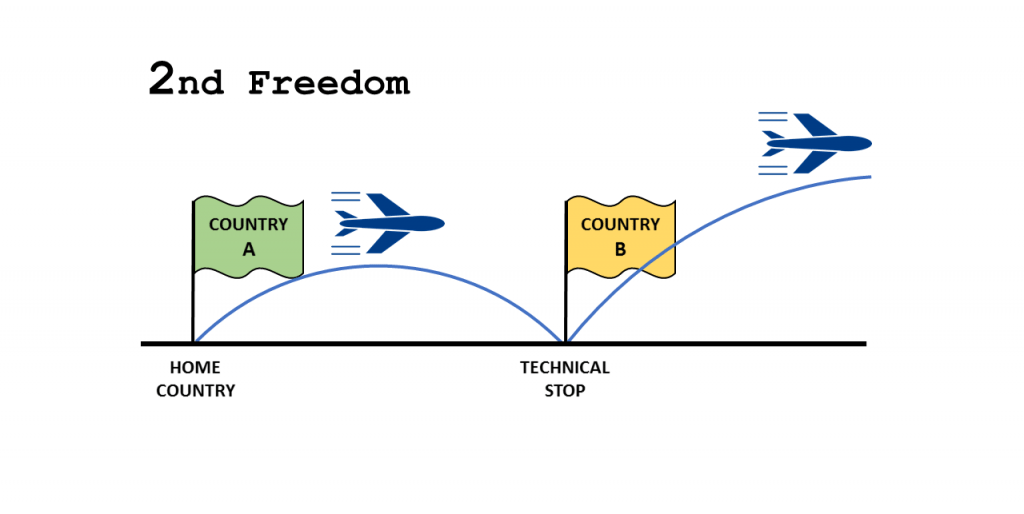Freedoms Of The Air
In my first couple of posts on this blog, I would like to write about some basic concepts of the industry so I could mention them in my later posts without additional explanation. Therefore, I want to start with explaining a very core concept of the international civil aviation: the freedoms of the air. They are a set of rights in commercial aviation regulating how the international airline transportation will be operated. Such a regulation is quite important, considering it involves the states’ sovereignity on their airspace. Granting a country’s airline the privilege to enter and land in another country’s airspace had become an issue of dispute during the phase of liberalisation of civil aviation.
This set of rights known as the freedoms of the air had been formulated during the Chicago Conference in 1944, and accepted by the signatory countries of the Convention on International Civil Aviation of 1944, aka the Chicago Convention. These freedoms are the key components of the international civil aviation, especially in terms of route network structuring. The use of any freedom of the air by commercial air transport companies depends on the grant of the entitlement for that “freedom” or “right” by the relevant countries with a bilateral or multilateral air services agreement.
While there are only five freedoms of the air defined in the Chicago Convention, several additional freedoms have been defined by a number of countries within bilateral agreements though not officially recognized by the international treaties. There are definitions for nine different freedoms of the air so far; however, ICAO characterizes all “freedoms” beyond the Fifth as “so-called” because only the first five “freedoms” have been officially recognized as such by international treaty. Beyond the first five, that could be easily derived that the higher the number of the freedom, the less common and more controversial it is.
Below, you may see the definitions of these nine freedoms with clarifying illustrations for each:
First Freedom of the Air – the right or privilege, in respect of scheduled international air services, granted by one State to another State or States to fly across its territory without landing (also known as a First Freedom Right or Overflight Right).

Second Freedom of the Air – the right or privilege, in respect of scheduled international air services, granted by one State to another State or States to land in its territory for non-traffic purposes (also known as a Second Freedom Right or Technical Landing Right).

Third Freedom of The Air – the right or privilege, in respect of scheduled international air services, granted by one State to another State to put down, in the territory of the first State, traffic coming from the home State of the carrier (also known as a Third Freedom Right).

Fourth Freedom of The Air – the right or privilege, in respect of scheduled international air services, granted by one State to another State to take on, in the territory of the first State, traffic destined for the home State of the carrier (also known as a Fourth Freedom Right).

Fifth Freedom of The Air – the right or privilege, in respect of scheduled international air services, granted by one State to another State to put down and to take on, in the territory of the first State, traffic coming from or destined to a third State (also known as a Fifth Freedom Right).

Sixth Freedom of The Air – the right or privilege, in respect of scheduled international air services, of transporting, via the home State of the carrier, traffic moving between two other States (also known as a Sixth Freedom Right).

The so-called Sixth Freedom of the Air, unlike the first five freedoms, is not incorporated as such into any widely recognized air service agreements such as the “Five Freedoms Agreement”. However, it is relatively more universal than the other higher numbered freedoms. Sixth Freedom is especially utilised by network carriers which use their home country as a connection hub for international transfers and carry passengers between two foreign countries with a stop in their own country.
Seventh Freedom of The Air – the right or privilege, in respect of scheduled international air services, granted by one State to another State, of transporting traffic between the territory of the granting State and any third State with no requirement to include on such operation any point in the territory of the recipient State, i.e the service need not connect to or be an extension of any service to/from the home State of the carrier.

Eighth Freedom of The Air – the right or privilege, in respect of scheduled international air services, of transporting cabotage traffic between two points in the territory of the granting State on a service which originates or terminates in the home country of the foreign carrier or (in connection with the so-called Seventh Freedom of the Air) outside the territory of the granting State (also known as a Eighth Freedom Right or “consecutive cabotage“).

Ninth Freedom of The Air – the right or privilege of transporting cabotage traffic of the granting State on a service performed entirely within the territory of the granting State (also known as a Ninth Freedom Right or “stand alone” cabotage).

Source: sametkasik.com.tr
Warning: Illegal string offset 'cookies' in /home/u623323914/domains/eng.bayviet.com.vn/public_html/wp-includes/comment-template.php on line 2564